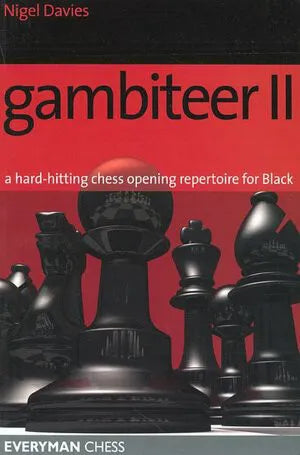Fight The Queen’s Gambit With The Albin Countergambit
If you’re a daring player hoping to defy the Queen’s Gambit with flair and zing, the Albin Countergambit might be just what you're looking for. By hitting back with 2...e5, Black saves the game from safe, predictable patterns and summons White to the razor's edge.
Featuring finely honed tactical tricks and traps, one notorious line even sees Black promote a pawn into a knight to win the game on move seven! It’s one of the reasons that the Albin Countergambit scores better for Black than any other reply to the Queen’s Gambit.

Albin Countergambit Statistics
The figures that back up the efficacy of the Albin Countergambit would likely surprise many chess players. According to the lichess.org database of online games, the gutsy gambit is Black’s most successful response at club level.
In over 200 million games played at all time controls by players rated between 1000 and 2000 Elo, the Albin Countergambit scores 48 points from every 100 games. That’s higher than the Slav Defense (2...c6), the Queen’s Gambit Declined (2...e6), and far superior to the Queen’s Gambit Accepted (2...dxc4).
The table below shows the statistics. Despite being played in only 4% of games, the Albin Countergambit (2...e5) scores better than any other response to the Queen’s Gambit.

Notice that, while the Albin Countergambit is superior, none of the responses score Black a majority or an equal score to White. The Queen’s Gambit really is one of the most powerful openings in chess — at both amateur and master levels!
3.dxe5
By far the most common response to the Albin Countergambit is for White to accept the pawn (3.dxe5). Indeed, this is the main line and the best move according to the best chess engines out there.
It’s also the move that Black was anticipating. With White’s d-pawn now out of the way, Black can now push its queen’s pawn forward (3...d4), where it becomes a remarkably stubborn thorn in White’s side. White can no longer develop its knight to c3, and the semi-open d-file remains precarious for an unfavorable queen swap.
If you were playing as White, how would you deal with Black’s d4 pawn now?

4.e3 and The Lasker Trap
One of the reasons that the Albin Countergambit boasts a superior record against the Queen's Gambit is a deadly trap. The Lasker Trap is a cutthroat continuation of the Albin Countergambit that relies only on White playing natural moves.
On the face of it, 4.e3 looks like a reasonable way for White to dislodge the pesky pawn. Yet it's just the move that Black is hoping for. Ignoring the center for now, Black finds a check, 4...Bb4+, that demands White defend its king with 5.Bd2. (Note that 5.Nd2 hands Black an advantage after 5...dxe3.)
Black continues with 5...dxe3 anyway. What? Black simply leaves its bishop hanging? Yes! And this is the bait for the treacherous trap to follow. If White captures the bishop (6.Bxb4), can you see the peril they find themselves in?

Did you find it? After 6.Bxb4, Black can play 6...exf2+. White can’t capture the pawn with its king without leaving its queen hanging! Instead, White must play 7.Ke2. Now, can you find the next genius move for Black?

It’s a genius move because it's a surprising one. If Black promotes the pawn into a queen, White can simply exchange queens with a check (8.Qxd8+) before capturing the newly promoted queen with its rook.
Instead, Black underpromotes its pawn into a knight! (7...fxg1+). Now, if White captures the knight, Black can swoop in with 8...Bg4+ and win the queen. If White plays 8.Ke1, Black continues the rampage with 8...Qh4+. The onslaught of checks to White's exposed king will win Black material and possibly checkmate, too. A triumph for Black! And a trap that all too many players fall into.
In All Other Cases, Play: 4...Nc6
Now, the Lasker Trap might be an exciting prospect, but remember, you won’t be playing it in most games! In fact, after 1. d4 d5 2. c4 e5 3. dxe5 d4, 71% of opponents play 4.Nf3.
Regardless of whether White plays 4.Nf3, 4.a3, or any move other than 4.e6, you need to play 4...Nc6. This is an obvious move to protect your pawn on d4 and ensure it continues to frustrate White! If White is later tempted to play e7-e6, you may still be able to terrorize them with similar themes seen in the Lasker Trap.

If White knows their game, however, they’ll continue with quiet moves like a2-a3 and g2-g3. While this seems rather passive, White is in a precarious position and needs to ride out the rest of the opening with due care!
5...Nge7
Whether White continues with 5.a3, 5.g3, 5.Nbd2, or even 5.Bg5, you continue with 5...Nge7. Why? You’re lining up 6...Ng6, threatening White’s outlying pawn on e5. On this awkward square, it’s difficult for White to defend.
Depending on what White plays, you also have the option to play Ne7-Nf5. This bolsters the pivotal d4 square and can be especially effective if White still chooses to play e2-e3. The frequently occurring position below arises from the moves: 1. d4 d5 2. c4 e5 3. dxe5 d4 4. Nf3 Nc6 5. a3 Nge7 6. e3 Nf5:

From here, what would you play with the white pieces?
By far White’s most popular response is 7.exd4, but it’s a mistake. Now Black can recapture with 7...Nfxd4, landing its knight in an imposing position. Understandably, White wants to dislodge it but only gets itself into deeper trouble if it continues the bloodbath on d4! After 8. Nxd4 Qxd4 9. Qxd4 Nxd4, Black’s knight is secure on the d4 outpost and threatening a fork on c2.
While this precise line isn’t something to anticipate in every game, it does highlight the danger that ...Nf5 can pose at an opportune moment!
What if White Declines the Albin Countergambit?
White’s best way to meet the Albin Countergambit is to take the free pawn (3.dxe5). Sometimes, however, you’ll meet a cautious player who prefers to veer off-piste. Here’s a rundown of your best responses to White’s other options:
- If White plays 3.Nc3 or 3.e3, capture on d4 and continue with normal development. You’ve already won an equal position.
- If White plays 3.cxd5, recapture with your queen. You’re now putting pressure on d4 and have won an equal position.
- If White plays 3.Nf3, play 3...e4. White will now need to retreat its knight to d2. If the knight tries to advance, you can simply continue to chase it with your pawns. Either way, you’ve gained tempos and won an advantage!

How to Avoid Playing Against the Queen’s Gambit and the London System
The Queen’s Gambit and the London System are two very solid openings for White that score very highly at club level. Both openings also tend to lead to rather dull, strategical games unless the opponent spices things up with a daring twist like the Albin Countergambit.
Sadly, even the Albin Countergambit doesn’t score a majority for Black, so you might be questioning whether it’s worth playing 1...d5 at all. There is another way! The table below shows statistics for each reply to 1.d4 at club level. Notice how poorly 1...d5 scores!

As a solid alternative, you could try the Indian Game (1...Nf6). This immediately lands you on more favorable ground from where you could explore exciting continuations like the Grunfeld Defense. Your opponent could still insist on the London System, however, which isn’t everyone’s idea of a scintillating game!
Looking at the statistics above, notice how one lesser-played response to 1.d4 scores Black a majority! Who knew that 1...c5, the Old Benoni Defense, would be Black’s highest-scoring answer to 1.d4 at club level? It also denies White either the Queen’s Gambit or the London System, so you can play the game on your own terms!
Conclusion: Is the Albin Countergambit Worth It?
The Albin Countergambit is a fun, action-packed answer to the Queen’s Gambit and a breath of fresh air compared to the dull, unimaginative play that often follows the opening. It’s especially enthralling if White falls into one of the traps involved, which happens remarkably often! It's well worth trying at club level, especially in blitz and bullet games where White may slip up more readily.
At the same time, stronger opponents will often succeed at refuting the Albin Countergambit with solid play. Even though it scores better than any other response to the Queen’s Gambit, it still doesn’t offer Black equal statistics.
If you're looking for an opening to give you the very best chances against 1.d4, do consider the Indian Game or if you're feeling adventurous, the Old Benoni Defense.






